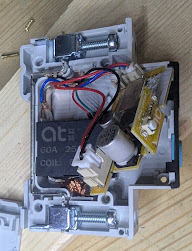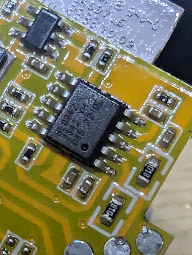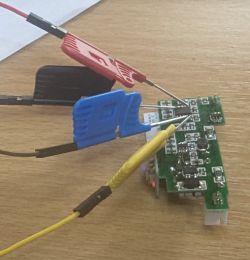Tongou TO-Q-SY1-JWT DIN Rail Switch and Meter
Maker: https://www.tongou.net/
Also on Aliexpress.
Installation
NOTE: Try not to lose the original calibration data. If you have set up the device with Tuya, first see Calibration and extract the calibration data from the running unit. And make sure you read the full 2MiB of the original flash before overwriting it.
These units generally ship with a firmware which is no longer exploitable by tuya-fwcutter, so some disassembly will be required to flash using serial.
First, the 6 rivets need to be drilled out with a 2mm drill bit. You'll need something to replace these when you reassemble the unit; M1.6 nuts and 16mm bolts work well.
Once open, lift out the control board so that you can see the BL0942 chip on the reverse side, behind the CBU module:


All the pins you need to flash the device are accessible from the BL0942 with SOIC probes:
- VDD / +3.3v (pin 1)
- GND (pin 5)
- RX (pin 9)
- TX (pin 10)
Note that the TX pin of the BL0942 corresponds to the RX pin of the BL72xx module, and vice versa.
You don't need to completely remove the board from the device, as shown in the picture below. But do not attempt to flash it while it's connected to the mains!

When ltchiptool says Getting bus... (now, please do reboot by CEN or by power off/on) first make sure you have read
the Calibration section and you are reading the flash before overwriting it. Then disconnect and
reconnect the GND line, and it should proceed.
Calibration
The factory calibration settings for the BL0942 are available in two ways. First, as DPS values 22-25 in the Tuya API, as reported by tools such as tinytuya, for example:
#!/bin/python3
import tinytuya
d = tinytuya.OutletDevice(
dev_id='DEVICE_ID_HERE',
address='IP_ADDRESS_HERE',
local_key='LOCAL_KEY_HERE',
version=3.4)
data = d.status()
print("UREF: %d" % data['dps']['22'])
print("IREF: %d * 10" % data['dps']['23'])
print("PREF: %d / 10" % data['dps']['24'])
print("EREF: %d" % data['dps']['25'])
Sample results:
UREF: 15968
IREF: 12418 * 10
PREF: 3091 / 10
EREF: 2653
Alternatively, the values may be stored in flash in the "key value store" Tuya partition, typically at address
0x001d5000 (in more recent devices this address changed to 0x001d9000):
001d5000 60 3e 00 00 82 30 00 00 13 0c 00 00 5d 0a 00 00 |`>...0......]...|
- UREF = 0x3e60 = 15968
- IREF = 0x3082 = 12418 (times ten to make 124180)
- PREF = 0xc13 = 3091 (divide by ten to make 309.1)
- EREF = 0xa5d = 2653
You can use these checks to validate the values you see:
- PREF = UREF × IREF × 3537 / (305978 × 73989)
- EREF = PREF × 3600000 / 419430.4
Applying those sanity checks to the example above, we get:
- PREF = 12968 × 124180 × 3537 / (305978 × 73989) = 309.8 (close enough)
- EREF = 309.1 × 3600000 / 419430.4 = 2653.0 (spot on)
The PREF values in the Tuya firmware are often a little lower than the calculation would suggest, but close enough that you can be confident you're looking at the right values.
If the calibration data are not available, it's still possible to calibrate the voltage and current against an external meter, and the power and energy calibrations can be calculated from that.
GPIO Pinout
| Pin | Function |
|---|---|
| RX1 | BL0942 Tx |
| TX1 | BL0942 Rx |
| P9 | Power LED (inverted) |
| P15 | Status LED (inverted) |
| P27 | Button (inverted) |
| P24 | Relay forward |
| P26 | Relay reverse |
Configuration
- Per-device configuration:
substitutions:
name: "power-light-spare2"
tongou_name: "10A spare 2"
voltage_ref: "15968"
current_ref: "124180"
power_ref: "309.1"
energy_ref: "2653"
packages:
tongou: !include tongou.yaml # below
- Generic config (
tongou.yaml):
# tongou.yaml
esphome:
name: ${name}
bk72xx:
board: generic-bk7231n-qfn32-tuya
packages:
base: !include base.yaml # WiFi and MQTT settings.
logger:
level: DEBUG
network:
enable_ipv6: false # Not supported on BL72xx yet
mqtt:
on_connect:
then:
- light.turn_on: led
on_disconnect:
then:
- light.turn_off: led
text_sensor:
- platform: libretiny
version:
name: LibreTiny Version
light:
- platform: status_led
internal: true
pin:
number: P15
inverted: true
id: led
restore_mode: ALWAYS_OFF
binary_sensor:
- platform: gpio
name: button
id: button
internal: true
pin:
number: P17
inverted: true
filters:
- delayed_off: 10ms
on_press:
then:
switch.toggle: relay
switch:
- platform: gpio
internal: true
pin: P24
id: relay_on
restore_mode: ALWAYS_OFF
- platform: gpio
internal: true
pin: P26
id: relay_off
restore_mode: ALWAYS_OFF
- platform: gpio
pin:
number: P9
inverted: true
id: relay
name: Relay
# On by default should be fine as this is not a safety device
restore_mode: RESTORE_DEFAULT_ON
on_turn_on:
then:
- switch.turn_off: relay_off
- switch.turn_on: relay_on
- delay: 100ms
- switch.turn_off: relay_on
on_turn_off:
then:
- switch.turn_off: relay_on
- switch.turn_on: relay_off
- delay: 100ms
- switch.turn_off: relay_off
uart:
id: uart_bus
tx_pin: TX1
rx_pin: RX1
baud_rate: 4800
stop_bits: 1
sensor:
- platform: internal_temperature
name: "${tongou_name} Internal Temperature"
- platform: bl0942
uart_id: uart_bus
line_frequency: 50Hz
address: 0
update_interval: 20s
current:
name: ${tongou_name} Current
voltage:
name: ${tongou_name} Voltage
power:
name: ${tongou_name} Power
filters:
multiply: -1
energy:
name: ${tongou_name} Energy
frequency:
name: ${tongou_name} Frequency
accuracy_decimals: 2
voltage_reference: ${voltage_ref}
current_reference: ${current_ref}
power_reference: ${power_ref}
energy_reference: ${energy_ref}